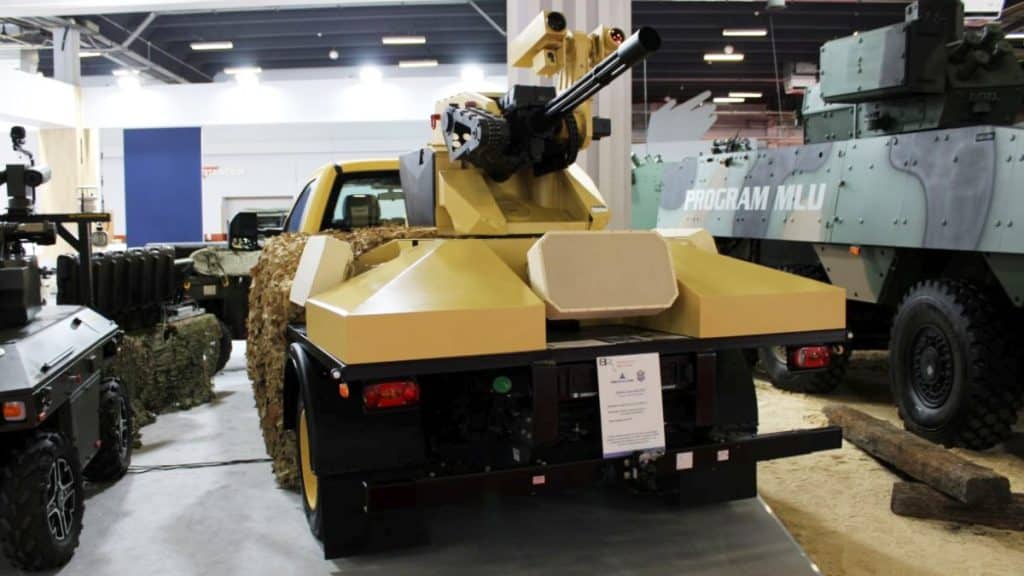The growing importance of the sword – unmanned systems of various classes – makes it necessary to work on a shield that will allow you to defend yourself against this type of air attack. This year’s MSPO was also an opportunity to present Polish achievements in the field of detection, identification, tracking and destruction of unmanned aerial vehicles.
One of the most interesting examples of equipment was the anti-firearms combat system based on the Ford 6060, shown by Zakłady Mechaniczne Tarnów. At the end of 2021, it carried out experimental shooting at the Central Air Force Training Ground in Ustka. The last tests of the technology demonstrator were carried out at the turn of March and April 2022.
The system has a curb weight of 660 kilograms and consists of three main components: a radar station, an optoelectronic head and a large-caliber machine gun as an effector. The system is based on a remotely controlled fire unit equipped with a 12.7 millimeter WKLM with an effective maximum range of 2,200 meters. The weapon is powered by a 12.7 × 99 mm NATO cartridge, the theoretical rate of fire is 3600 rounds per minute. The stock of ammunition is 400 pieces.
A multifunctional Doppler radar with three fixed AESA 4D antennas with an electronically controlled beam was used. According to the manufacturer, this makes it possible to detect moving nano-class drones from a distance of up to 3.5 kilometers, UAV mini appear on the radar at a distance of up to 10 kilometers, rocket / artillery missiles – at a distance of up to 7 kilometers, and a manned helicopter is detected from 23 kilometers.
(ZM Tarnów SA)
Equipped with an optoelectronic head allows detection and identification of the target. The fire control system is based on automatic target tracking and automatic target tracking algorithms from the moment it is detected by the radar station until the shot is fired. The head is equipped with a television camera with a resolution of 1920 × 1080 pixels and an infrared sensor that allows the detection of objects at a distance of 13.6 kilometers. A laser rangefinder with a range of 3–12 kilometers and a measurement frequency of up to 200 hertz, as well as a radar and a precise drive system steering the fire medium.
The manufacturer draws attention to the modular architecture of the system, which enables easy reconfiguration. An additional advantage is the requirement to operate only with electricity. The product from Tarnów can work in three modes with varying degrees of automation: machine gun control without the use of pointing devices, indication of a target for tracking on the basis of radar data, automatic interception with the MG operator deciding only when the shot is fired. The operator interface allows you to adjust the length of the series with the wkm.
(Andrzej Pawłowski, Konflikty.pl)
The system can be a mobile security umbrella for army groups, field workshops, improvised airfields and landing sites. It can be used as a short-range air defense system as well as a “last resort” system when other systems have failed.
The system can be mounted on a stationary or mobile platform, including an armored car chassis or a towed trailer. It is also possible to use it on small ships as a direct defense system. The project “UAV combat system” is implemented in 2018-2022 by the consortium of ZM Tarnów and the Military University of Technology. Jarosław Dąbrowski.
(Andrzej Pawłowski, Konflikty.pl)
The offer of ZM Tarnów is related to the proposal of Advanced Protection Systems (APS) from Gdynia. In 2018, the company debuted at the fair with the Ctrl + Sky drone detection and anti-drone system mounted on the pick-up. At that time, APS informed that it could operate in a stationary, portable version and mounted on any type of vehicle on a tripod or a hydraulically lifted platform.
Today, the system is to have a range of 6 kilometers and can be a soft-kill weapon, but also act as part of larger systems integrated with hard-kill effectors. The basis are FIELDctrl three-coordinate radars. An example of such radars can be seen on the Ford 6060 shown in the pictures above. The radars are integrated with the head of the jamming system with sector or directional antennas. The system can operate in two modes – manual and automatic – in which the operator decides to neutralize the target or destroy it autonomously according to pre-established rules.
(Andrzej Pawłowski, Konflikty.pl)
Target tracking – both single and swarms of drones – is carried out on the operator console on which C2 CyView software is installed. Thanks to this, it was possible to distinguish birds from drones (even when a flock mixes with drones), display a 3D image and indicate the exact position of the object in real time.
FIELDctrl radars were also presented on the unarmed Rosomak with a light mesh cover to protect against the effects of PG 7W and PG 7WM HEAT shells. In the Advance version, the radars are to detect nano class drones from a distance of 3 kilometers, and light armored vehicles and helicopters at low altitudes – from 10 kilometers. APS boasts that FIELDctrl radars have been delivered to the Gulf countries of Saudi Arabia, Qatar and the United Arab Emirates. In addition, anti-drone systems are used in the Tallinn prison and Stavanger airport.
See also: Qatar Air Force took back the first Typhoon
Andrzej Pawłowski, Konflikty.pl

